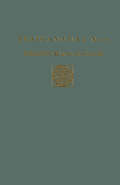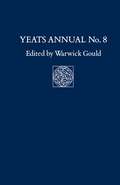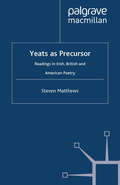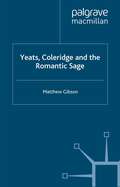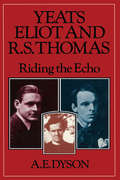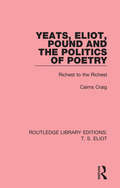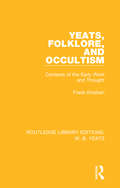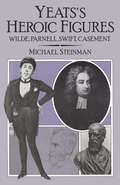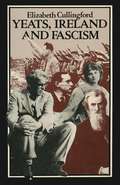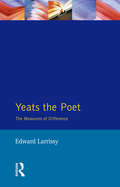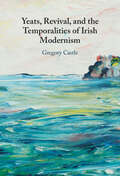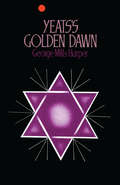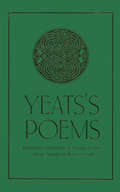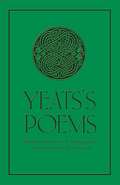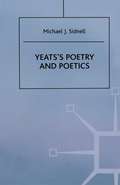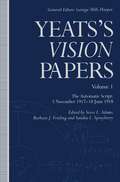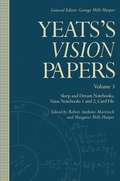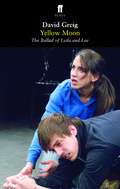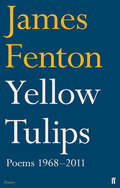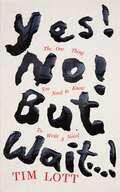- Table View
- List View
Yeats Annual No 7: including Essays in Memory of Richard Ellmann (Yeats Annual)
by Warwick GouldThe essays in Yeats Annual No 7 are dedicated to the memory of Richard Ellmann, one of the great pioneer critics of W.B.Yeats. They have been contributed by distinguished colleagues and friends of Richard Ellmann, chosen on his advice. The volume also contains much new material by Yeats himself - a new and virtually complete early draft of his novel The Speckled Bird, here entitled 'The Lilies of the Lord' and two new poems from The Flame of the Spirit manuscript book, given to Maud Gonne in 1981.
Yeats Annual No. 8 (Yeats Annual)
by Warwick GouldYeats Annual No.8 has two distinct themes: Yeats's poetic technique and his aims for an Irish Theatre. Essays from Helen Vendler, Richard Taylor, Timothy Armstrong and Wayne Chapman place the poetry under close scrutiny and offer challenging new studies. Yeats himself writes the remaining essays, including the long-awaited first publication of his Wildean dialogue and an uncollected address on the Irish National Theatre delivered in 1934. Richard Londraville edits four of Yeats's lectures given in England and America in 1902-4.
Yeats as Precursor: Readings in Irish, British and American Poetry
by S. MatthewsAs both a late Romantic and a modern, W.B. Yeats has proved to be perhaps the most influential poet of the early twentieth-century. In this original study Steven Matthews traces, through close readings of significant poems, the flow of Yeatsian influence across time and cultural space. By engaging with the formalist criticism of Harold Bloom and Paul de Man in their dialogues with Jacques Derrida, he also considers Yeats's significance as the founding presence within the major poetry criticism of the century.
Yeats, Coleridge and the Romantic Sage
by M. GibsonThis work explores an aspect of Yeats's writing largely ignored until now: namely, his wide-ranging absorption in S.T. Coleridge. Gibson explores the consistent and densely woven allusions to Coleridge in Yeats's prose and poetry, often in conjunction with other Romantic figures, arguing that the earlier poet provided him with both a model of philosopher - 'the sage' - and an interpretation of metaphysical ideas which were to have a resounding effect on his later poetry, and upon his rewriting of A Vision.
Yeats, Eliot, Pound and the Politics of Poetry: Richest to the Richest (Routledge Library Editions: T. S. Eliot)
by Cairns Prof. CraigIt has long been recognised that there is an apparently paradoxical relationship between the revolutionary poetic style developed by Yeats, Eliot and Pound in the period during and after the First World War, and the reactionary politics with which they were associated in the 1920s and 1930s. Concentrating on their writings in the period up to the 1930s, this study, first published in 1982, helps to resolve the paradox and also provides a much needed reappraisal of the factors influencing their poetic and political development. The work of these poets has usually been seen as deriving from the tradition of continental symbolist poetics. Yeats, Eliot, Pound and the Politics of Poetry will be of interest to students of literature.
Yeats, Eliot, Pound and the Politics of Poetry: Richest to the Richest (Routledge Library Editions: T. S. Eliot #2)
by Cairns Prof. CraigIt has long been recognised that there is an apparently paradoxical relationship between the revolutionary poetic style developed by Yeats, Eliot and Pound in the period during and after the First World War, and the reactionary politics with which they were associated in the 1920s and 1930s. Concentrating on their writings in the period up to the 1930s, this study, first published in 1982, helps to resolve the paradox and also provides a much needed reappraisal of the factors influencing their poetic and political development. The work of these poets has usually been seen as deriving from the tradition of continental symbolist poetics. Yeats, Eliot, Pound and the Politics of Poetry will be of interest to students of literature.
Yeats, Folklore and Occultism: Contexts of the Early Work and Thought (Routledge Library Editions: W. B. Yeats)
by Frank KinahanThis lively introduction to the poems of W. B. Yeats, first published in 1988, provides a series of intriguing new readings of his work in relation to his profound involvement with occultism and folklore. During Yeats’s formative years as an artist, two compelling movements were emerging: the revivals of interest in Irish folklore and in the mag
Yeats, Folklore and Occultism: Contexts of the Early Work and Thought (Routledge Library Editions: W. B. Yeats)
by Frank KinahanThis lively introduction to the poems of W. B. Yeats, first published in 1988, provides a series of intriguing new readings of his work in relation to his profound involvement with occultism and folklore. During Yeats’s formative years as an artist, two compelling movements were emerging: the revivals of interest in Irish folklore and in the mag
Yeats The Poet: The Measures of Difference
by Edward LarrissyThis work addresses Yeats's "antinomies", seeing their origin and structure in his divided Anglo-Irish inheritance and examining the notion of measure. It then explores how this relates to freemasonry, Celticism and Orientalism and looks at the Blakean esoteric language of contrariety and outline which provided Yeats with the vocabulary of self-understanding.
Yeats The Poet: The Measures of Difference
by Edward LarrissyThis work addresses Yeats's "antinomies", seeing their origin and structure in his divided Anglo-Irish inheritance and examining the notion of measure. It then explores how this relates to freemasonry, Celticism and Orientalism and looks at the Blakean esoteric language of contrariety and outline which provided Yeats with the vocabulary of self-understanding.
Yeats, Revival, and the Temporalities of Irish Modernism
by null Gregory CastleYeats, Revival, and the Temporalities of Irish Modernism offers a new understanding of a writer whose revivalist commitments are often regarded in terms of nostalgic yearning and dreamy romanticism. It counters such conventions by arguing that Yeats's revivalism is an inextricable part of his modernism. Gregory Castle provides a new reading of Yeats that is informed by the latest research on the Irish Revival and guided by the phenomenological idea of worldmaking, a way of looking at literature as an aesthetic space with its own temporal and spatial norms, its own atmosphere generated by language, narrative, and literary form. The dialectical relation between the various worlds created in the work of art generate new ways of accounting for time beyond the limits of historical thinking. It is just this worldmaking power that links Yeats's revivalism to his modernism and constructs new grounds for recognizing his life and work.
Yeats’s Golden Dawn: The Influence Of The Hermetic Order Of The Golden Dawn On The Life And Art Of W.b. Yeats
by George Mills HarperYeats's Legacies: Yeats Annual No. 21 (Yeats Annual Ser. #Vol. 21)
by Warwick GouldThe two great Yeats Family Sales of 2017 and the legacy of the Yeats family’s 80-year tradition of generosity to Ireland’s great cultural institutions provide the kaleidoscope through which these advanced research essays find their theme. Hannah Sullivan’s brilliant history of Yeats’s versecraft challenges Poundian definitions of Modernism; Denis Donoghue offers unique family memories of 1916 whilst tracing the political significance of the Easter Rising; Anita Feldman addresses Yeats’s responses to the Rising’s appropriation of his symbols and myths, the daring artistry of his ritual drama developed from Noh, his poetry of personal utterance, and his vision of art as a body reborn rather than a treasure preserved amid the testing of the illusions that hold civilizations together in ensuing wars. Warwick Gould looks at Yeats as founding Senator in the new Free State, and his valiant struggle against the literary censorship law of 1929 (with its present-day legacy of Irish anti-blasphemy law still presenting a constitutional challenge). Drawing on Gregory Estate documents, James Pethica looks at the evictions which preceded Yeats’s purchase of Thoor Ballylee in Galway; Lauren Arrington looks back at Yeats, Ezra Pound, and the Ghosts of The Winding Stair (1929) in Rapallo. Having co-edited both versions of A Vision, Catherine Paul offers some profound reflections on ‘Yeats and Belief’. Grevel Lindop provides a pioneering view of Yeats’s impact on English mystical verse and on Charles Williams who, while at Oxford University Press, helped publish the Oxford Book of Modern Verse. Stanley van der Ziel looks at the presence of Shakespeare in Yeats’s Purgatory. William H. O’Donnell examines the vexed textual legacy of his late work, On the Boiler while Gould considers the challenge Yeats’s intentionalism posed for once-fashionable post-structuralist editorial theory. John Kelly recovers a startling autobiographical short story by Maud Gonne. While nine works of current biographical, textual and literary scholarship are reviewed, Maud Gonne is the focus of debate for two reviewers, as are Eva Gore-Booth, Constance and Casimir Markievicz, Rudyard Kipling, David Jones, T. S. Eliot and his presence on the radio.
Yeats's Legacies: Yeats Annual No. 21 (Yeats Annual #21)
by Warwick GouldThe two great Yeats Family Sales of 2017 and the legacy of the Yeats family’s 80-year tradition of generosity to Ireland’s great cultural institutions provide the kaleidoscope through which these advanced research essays find their theme. Hannah Sullivan’s brilliant history of Yeats’s versecraft challenges Poundian definitions of Modernism; Denis Donoghue offers unique family memories of 1916 whilst tracing the political significance of the Easter Rising; Anita Feldman addresses Yeats’s responses to the Rising’s appropriation of his symbols and myths, the daring artistry of his ritual drama developed from Noh, his poetry of personal utterance, and his vision of art as a body reborn rather than a treasure preserved amid the testing of the illusions that hold civilizations together in ensuing wars. Warwick Gould looks at Yeats as founding Senator in the new Free State, and his valiant struggle against the literary censorship law of 1929 (with its present-day legacy of Irish anti-blasphemy law still presenting a constitutional challenge). Drawing on Gregory Estate documents, James Pethica looks at the evictions which preceded Yeats’s purchase of Thoor Ballylee in Galway; Lauren Arrington looks back at Yeats, Ezra Pound, and the Ghosts of The Winding Stair (1929) in Rapallo. Having co-edited both versions of A Vision, Catherine Paul offers some profound reflections on ‘Yeats and Belief’. Grevel Lindop provides a pioneering view of Yeats’s impact on English mystical verse and on Charles Williams who, while at Oxford University Press, helped publish the Oxford Book of Modern Verse. Stanley van der Ziel looks at the presence of Shakespeare in Yeats’s Purgatory. William H. O’Donnell examines the vexed textual legacy of his late work, On the Boiler while Gould considers the challenge Yeats’s intentionalism posed for once-fashionable post-structuralist editorial theory. John Kelly recovers a startling autobiographical short story by Maud Gonne. While nine works of current biographical, textual and literary scholarship are reviewed, Maud Gonne is the focus of debate for two reviewers, as are Eva Gore-Booth, Constance and Casimir Markievicz, Rudyard Kipling, David Jones, T. S. Eliot and his presence on the radio.
Yeats’s Poems
by Warwick GouldWilliam Butler Yeats is considered Ireland's greatest poet. He is one of the most significant literary figures of the twentieth century. He was awarded the Nobel Prize for Literature in 1923. This is the definitive collection of his poems, encompassing the full range of his powers, from the love lyrics to the political poems, from poems meditating on the bliss of youth, to the verse that rails against old age. A detailed notes section and full appendix provide an invaluable key to the poems as well as biographical information on the life of the poet and a guide to his times. The collection includes Yeats's fourteen books of lyrical poems, his narrative and dramatic poetry, and his own notes on individual poems.
Yeats’s Poems
by W. B. YeatsHere in one volume is the entire canon of Yeat's verse, who was awarded the Nobel Prize for Literature in 1923. He was a poet and playwright, storyteller and visionary. The author also wrote "Yeats: Man and Poet".
Yeats’s Poetry and Poetics
by Michael J. SidnellYeats's Poetry and Poetics brings together some of the finest Yeats criticism ever published, together with some new pieces specially written for this volume. Spanning the whole of Yeats's career, the essays are organised into three main parts. The first deals with Yeats's concern with the speaking voice and its bearing on public and private readings of his verse; and on his use of certain kinds of images in his poetry and plays, from ghosts and fairies, to figures borrowed from painters and sculptors and, extraordinarily, to the actual dancer for whom he makes room in his work. The second section puts Yeats's poetry in context with the work of Synge, D.H. Lawrence, Walter de la Mare and other 'Georgians', and with that of T.S. Eliot and other modernists; assessing the continuities (real and asserted) in Yeats's long poetic career against the revolutions in the poetry of his time. The profound connections between the writings of Yeats and Joyce, including the coupling of Finnegans's Wake and 'The Wanderings of Oisin' are also examined. Rounding off the volume 'Phantasmagoria', explores the implications for his poetics of Yeats's spiritualist philosophy, especially in terms of his conception of the poetic self, and, finally, the last section analyses two works animated by Yeats's quest for the 'faery bride' and his desperate attempt to attract, through his work, a real one.
Yeats's "Vision" Papers: The Automatic Script - 5 November, 1917 to 23 September, 1918 (Yeats's 'Vision' Papers)
by W. B. YeatsThe first volume of a three-volume edition of the collected papers and notebooks which comprise the "automatic writing" of W.B.Yeats. This material, which spans the years between 1917 and 1920, contains Yeats' thoughts concerning literature and art, which in turn, comprises his "vision".
Yeats’s Vision Papers: Volume 3: Sleep and Dream Notebooks, Vision Notebooks 1 and 2, Card File (Yeats's 'Vision' Papers)
by W. B. YeatsThe third volume of a three volume edition of the collected papers and notebooks which comprise the "automatic writing" of W.B.Yeats. The material presented here is taken from the writings known as "the sleep and dreams" notebooks, the "vision" notebooks one and two and from Yeats' card files.
Yellow Moon: The Ballad Of Leila And Lee
by David GreigYellow Moon is a modern Bonnie and Clyde tale that follows the fortunes of two teenagers on the run. Silent Leila is an introverted girl who has a passion for celebrity magazines. Stag Lee Macalinden is the deadest of dead-end kids in a dead-end town. They never meant to get mixed up in a murder... but now they need a place to hide.Yellow Moon explores what it means to live in a celebrity-obsessed world and what it is that defines who you are when you're 17 years old. The play premiered at the Circle Studio of Citizens' Theatre, Glasgow, in September 2006, and won the 2008 Brain Way Award for Best Play for Young People.
Yellow Tulips: Poems 1968–2011
by James FentonWinner of both the Queen's Gold Medal and the Whitbread Prize for Poetry, James Fenton has given readers some of the most memorable lyric verse of the past decades, from the formal skill that marked his debut, Terminal Moraine, to the dramatic and political monologues of The Memory of War and Children in Exile, through to the unforgettable love poems of Out of Danger and his most recent work: Poems is an essential selection by, as Stephen Spender put it, 'a brilliant poet of technical virtuosity'.Don't talk to me of love. I've had an earfulAnd I get tearful when I've downed a drink or two.I'm one of your talking wounded.I'm a hostage. I'm maroonded.But I'm in Paris with you.From 'In Paris With You' by James Fenton
Yes! No! But Wait...!: The One Thing You Need to Know To Write a Novel
by Tim LottAt the heart of writing – at the apex of storytelling – there is only one principle, and it winds like a golden thread across all the books and courses. But it gets lost in the ever-spreading panoply of detail that the creative writing industry relies on to keep its wheels turning. This book pulls out that thread, polishes it and reveals the way it penetrates storytelling. It will be invaluable to anyone creating fictional worlds - but most particularly to novelists, who are most in danger of forgetting it. Or not noticing it in the first place. Tim Lott knows he can’t teach anyone to write a novel (that’s one of the lies propagated by the novel-writing industry). But he can teach someone how to build a firm platform on which they can stand in order to explore whether they have the talent, will and determination that writing a novel takes.
